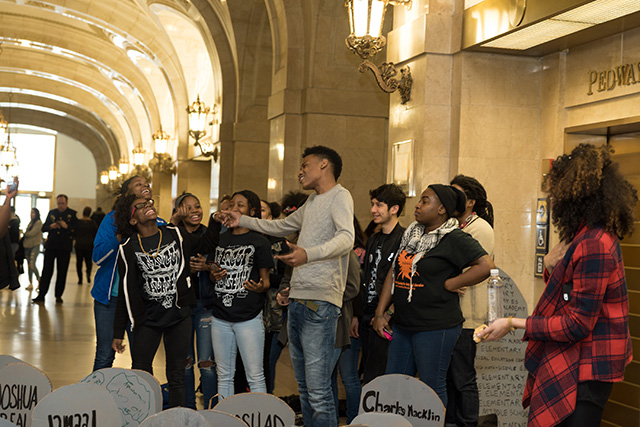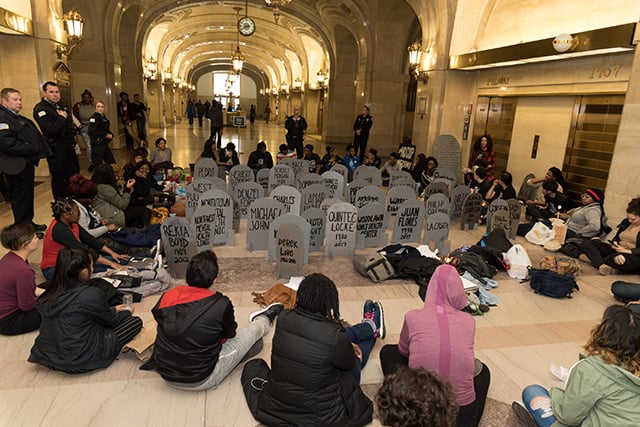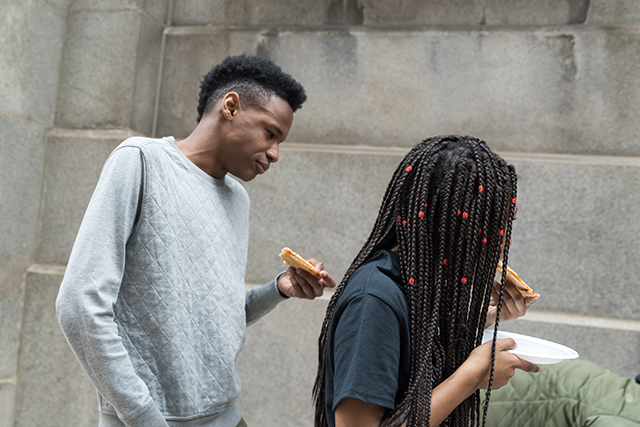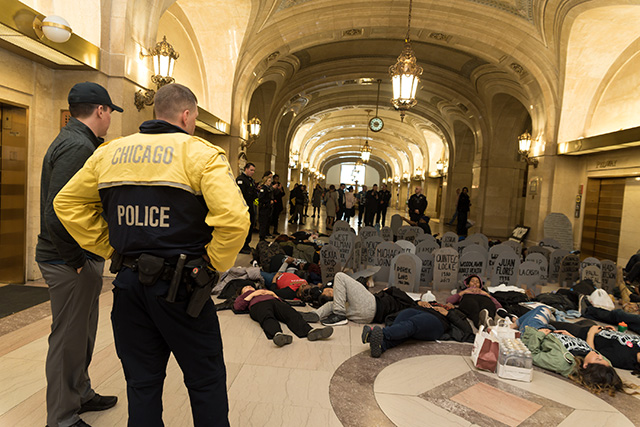
 Chicago student organizers stage a die-in at Chicago’s City Hall on Wednesday to protest a proposed police academy facility. Students created cardboard headstones in memory of people killed by police as well as community hubs, such as schools and clinics, that have been shuttered under Chicago Mayor Rahm Emanuel. (Photo: Sarah-Ji)
Chicago student organizers stage a die-in at Chicago’s City Hall on Wednesday to protest a proposed police academy facility. Students created cardboard headstones in memory of people killed by police as well as community hubs, such as schools and clinics, that have been shuttered under Chicago Mayor Rahm Emanuel. (Photo: Sarah-Ji)It’s spring break for Chicago’s public school students, and some of the city’s young people are taking the opportunity to protest. This week, dozens of high school and middle school students from the city’s South and West Sides have participated in a series of actions to demand that Chicago’s City Council halt the proposed construction of a new $95 million training facility for the Chicago Police Department.
The training facility, like the city’s police department, has been mired in controversy. Young activists, who say the $95 million should instead be invested in their communities have flyered, staged protests and held teach-ins in opposition to the project since last summer, building significant community support.
The city was also hit with a lawsuit on Monday filed by activists with the #NoCopAcademy campaign who are seeking to expose emails and records that they believe will disprove Chicago Mayor Rahm Emanuel’s claims that the police academy is being built in response to recommendations from the Department of Justice (DOJ). Activists say available evidence indicates that the project was being planned months before the DOJ report, which offered a scathing review of Chicago police practices, was released.
 Students lift each other’s spirits and amplify their message with speakouts and performances during their daylong protest at Chicago’s City Hall on Wednesday. (Photo: Sarah-Ji)
Students lift each other’s spirits and amplify their message with speakouts and performances during their daylong protest at Chicago’s City Hall on Wednesday. (Photo: Sarah-Ji)But despite public outcry, Chicago’s City Council is expected to vote to approve the contractor and design of the facility later this spring. Students and adults opposed to the project attended a Chicago City Council meeting on Wednesday to voice their disapproval of the project.
Chicago Mayor Rahm Emanuel left the room during the discussion, returning after it was over.
Black Lives Matter organizer Maria Hernandez, who spoke at the City Council meeting, told Truthout, “I shared some of the initial findings of a massive survey of communities bordering this proposed academy.” Hernandez, a 27-year-old West Side resident, who has worked closely with the students who are leading the campaign, says the campaign’s findings indicate that “almost three-quarters [of affected residents] haven’t heard of the city’s plans, and almost everyone we spoke to was opposed and had alternate recommendations for city investment.” Later in the meeting, the youth started a “mic check” to voice their position and were removed from the meeting.
“There were a few moments when I was a little scared of what they were going to do to us,” 17-year-old student organizer Karla Dejesus told Truthout. Dejesus, who lives in Chicago’s Pilsen neighborhood, told Truthout in an interview that she was handled roughly by City Hall security. “The security guard grabbed me with force even though I tried to seem like I was just chilling,” says Dejesus, adding that the young protesters were frightened and unnerved by police repeatedly throughout the day. “I was scared that if we didn’t go record them, they’d do something.”
According to Hernandez, after being ejected from the City Council meeting, the students wanted to go to the fifth floor, where the mayor’s office is located, but the police would not allow it. “Cops held the doors when elevators got to the lobby,” says Hernandez. “Youth insisted on going to the fifth floor, so police shut down the elevators and told us — I was in one — that once the doors closed we would be locked inside. As the doors to the elevators were about to close,” says Hernandez, “we chose to leave rather than be trapped.”
 Chicago student organizers maintained a daylong presence at Chicago’s City Hall on Wednesday to protest a proposed police academy facility. Students created cardboard headstones in memory of people killed by police as well as community hubs, such as schools and clinics, that have been shuttered under Chicago Mayor Rahm Emanuel. (Photo: Sarah-Ji)
Chicago student organizers maintained a daylong presence at Chicago’s City Hall on Wednesday to protest a proposed police academy facility. Students created cardboard headstones in memory of people killed by police as well as community hubs, such as schools and clinics, that have been shuttered under Chicago Mayor Rahm Emanuel. (Photo: Sarah-Ji)After being forced off the elevators, the youth protesters continued their demonstration in the building’s lobby. “They wanted us to leave but instead the teens set up a funeral,” says Hernandez, “with tombstones placed in the first floor of City Hall bearing 95 names [an allusion to the $95 million that the city plans to spend on the police academy] … of people, schools and clinics that died as a result of this city’s policies. The students called on the ancestors, sang, danced, shared poetry, played games and taught each other new chants.”
The #NoCopAcademy campaign is led by young Black people from Assata’s Daughters and the recently formed Simeon Young Activists Club, and is backed by over 65 community organizations across the city and country. On Wednesday, two hours into the protest, which did not obstruct the work of city employees, police barred the predominantly Black group of youth protesters from using the building’s public bathrooms for at least two hours.
The historical baggage of denying Black youth access to public restrooms, in a country where “separate but equal” was once the law of the land, was apparently lost on Chicago officials. At the two-hour mark, organizers were also told they couldn’t bring food or water for the young protesters inside. The city’s treatment of the students sparked discussion on social media, as numerous people attempted to deliver food to the students, with mixed success. “White people were still allowed to enter and exit freely with food, so we had to have people bring bags directly to us,” says Hernandez, adding that “a youth of color was surrounded by four police officers for trying to bring in some chicken.”
“The food part got really irritating for me,” says Dejesus, “because they were letting white folks in with their food … and although I’m extremely grateful that [the white folks] used their privilege for that, it ticked me off that [the cops] were saying it wasn’t allowed because everyone around us had food.” Dejesus says she was pacing the amount of liquid she drank during the protest “because I knew that they weren’t letting us use the bathrooms for a while.”
 Students protesting at Chicago’s City Hall take breaks to eat pizza from supporters outside the building after police refuse to allow food deliveries to the young protesters. (Photo: Sarah-Ji)
Students protesting at Chicago’s City Hall take breaks to eat pizza from supporters outside the building after police refuse to allow food deliveries to the young protesters. (Photo: Sarah-Ji)
As a local organizer who has participated in numerous actions at Chicago’s City Hall, I have never seen protesters denied access to the building’s bathrooms while the building was officially open. During a sit-in, the bathrooms are typically locked at 5:00 p.m., when the building closes, to encourage protesters to leave. I have likewise never had trouble bringing in food for myself or for other demonstrators.
While police eventually relented, and allowed the youth to access the building’s bathrooms, after two hours of denying them access, the indignity the young protesters were subjected to — watching as others were allowed to use a public bathroom that they were denied access to — offered a painful reminder that the systemic injustices that previous generations of Black activists fought, and in some cases died to overcome, have not faded into the recesses of history.
Students seemed undeterred by the dehumanizing treatment they received at City Hall, which included a large number of police encroaching on their personal space and surveilling them all day. According to Hernandez, “The chant that echoed the halls of government on Wednesday says it all: ‘We know the truth, we got the stats, if the city’s so broke where you get that money at?'”
 Police watch as Chicago students die-in at City Hall in protest of Rahm Emanuel’s proposed police training facility. (Photo: Sarah-Ji)
Police watch as Chicago students die-in at City Hall in protest of Rahm Emanuel’s proposed police training facility. (Photo: Sarah-Ji)
As student organizer Nisa Perez, 14, told Truthout: “We were there because Rahm was there, and we wanted him to see us. We wanted him to see that the people did not believe in what he is doing, and that we will fight to make sure that he knows that.”
In being denied access to food and public bathrooms during their sit-in this week, young protesters in Chicago learned that if Black children come to City Hall to declare Rahm Emanuel isn’t on their side, they may be subjected to indignities we would all like to think are the stuff of history.
Even as the Parkland students have gained unprecedented public support for their protests against gun violence, the dehumanizing treatment of Black student protesters in Chicago shows that Rahm Emanuel isn’t worried that the wider public will rally behind these youth the way that people have rallied behind the Parkland students. Emanuel assumes the public won’t react to his treatment of these students for the same reason he assumes he can close their neighborhood schools and clinics without consequence: He doesn’t believe the public will ever effectively galvanize behind Black children. With the #NoCopAcademy campaign, young organizers are presenting the public with a powerful opportunity to prove Emanuel wrong.
Join us in defending the truth before it’s too late
The future of independent journalism is uncertain, and the consequences of losing it are too grave to ignore. To ensure Truthout remains safe, strong, and free, we need to raise $27,000 in the next 24 hours. Every dollar raised goes directly toward the costs of producing news you can trust.
Please give what you can — because by supporting us with a tax-deductible donation, you’re not just preserving a source of news, you’re helping to safeguard what’s left of our democracy.